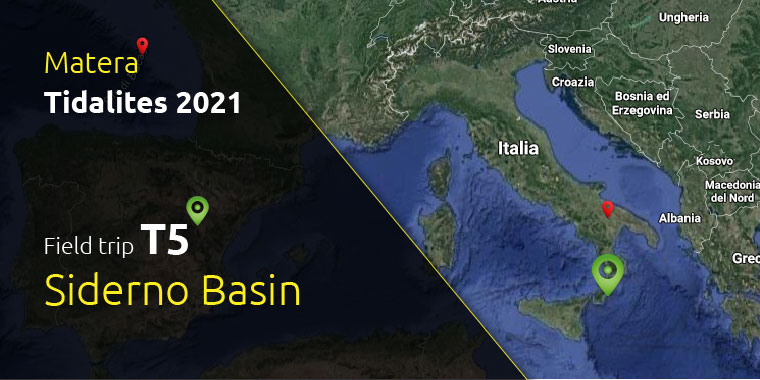Post-Congress Field Trip
6-8 May 2022
From marginal to axial tidal-strait facies in the lower Pleistocene Siderno Strait
Valentina M. Rossi (IGG-CNR, Italy)
Sergio G. Longhitano (University of Basilicata, Italy)
Domenico Chiarella (Royal Holloway University, London, UK)
Donatella Mellere (DNO E&P, Stavanger Norway)
Francesco Muto (University of Calabria, Italy)
Vincenzo Tripodi (University of Calabria, Italy)

Description
The Siderno Strait was the largest among the tectonically controlled tide-dominated conduits that dissected the Calabrian Arc in southern Italy during the early Pleistocene. The WNW-ESE trending, 50×20 km-wide Siderno Strait connected the Tyrrhenian with the Ionian seas. Due to tidal phase opposition between the two basins, continuous water-mass exchanges occurred through the strait, leading to reversal tidal currents flowing bi-directionally. Sediments derived from the mixing of fluvial supply discharged from the strait margins with abundant intra-basinal autochthonous carbonate-factory debris.
The trip’s itinerary starts from the northern, tectonically-controlled border of the strait and ends in the deeper axial zone.
The first day provides a number of stops located along the progradational axis of a tidally-deflected fan-delta complex impinging the Siderno Strait from the northern margin. The sedimentological features and depositional architectures of proximal fluvial-dominated deposits are compared with distal, delta-front tide-dominated deposits, these latter exhibiting a variety of scales of cross bedding and reflecting the deflection of the deltaic progradational axis imparted by powerful tidal currents.
The second day focuses on the observation of ca. 150-190 m-thick cross-bedded mixed bioclastic-siliciclastic deposits, forming a series of tidal ridges elongated WNW-ESE and accumulated in the south-eastern axial zone of the Siderno Strait. The stops offer panoramic views of exceptionally continuous sections and close-up observations, revealing different scales of depositional architectures and a variety of sedimentary structures and ichnotraces that record the development of these tidal sand ridges during the strait lifespan. The interplay between the tectonic uplift of a central sill and a number of sin-sedimentary faults and high-frequency sea-level changes can be deciphered from the architecture of the tidal cross beds composing the main body of the ridges.
Logistics
The trip will start from Matera and will end in Lamezia Terme. Participants are advised to plan their return flight from that airport, which provides domestic and international connections to some major European airports.
Number of participants
min 12 – max 25
Cost
500 Euros (inclusive of transport, accommodation, meals and material)
Geological Field Trips and Maps - Volume 13 (1.4)/2021
From marginal to axial tidal-strait facies in the Early Pleistocene Siderno Strait
DOI: https://doi.org/10.3301/GFT.2021.04 - Pages: 1-51
Download the open-access field guide at the following button


















